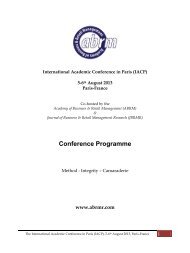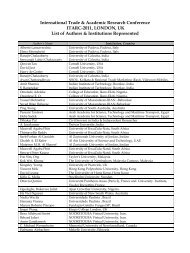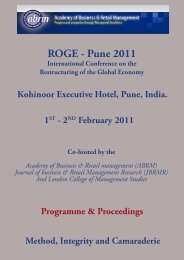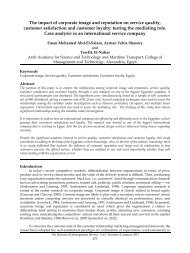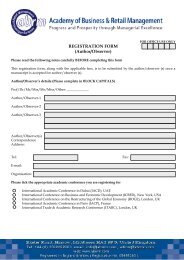THE BUSINESS & MANAGEMENT REVIEW - The Academy of ...
THE BUSINESS & MANAGEMENT REVIEW - The Academy of ...
THE BUSINESS & MANAGEMENT REVIEW - The Academy of ...
Create successful ePaper yourself
Turn your PDF publications into a flip-book with our unique Google optimized e-Paper software.
growth could increase the ratio <strong>of</strong> taxes to GDP. So, a positive coefficient is expected for this variable.<br />
<strong>The</strong> effect <strong>of</strong> inflation on the ratio <strong>of</strong> taxes to GDP is not clear. On one side, higher inflation<br />
increases inflation tax for government and decreases the need to levy conventional taxes. Also, in<br />
inflationary conditions, firms and individuals tend to evade or at least to delay paying taxes to benefit<br />
from the erosion <strong>of</strong> their real tax liabilities due to inflation. On the other hand, inflation increases tax<br />
liabilities because nominal incomes increase and taxes are usually levied on nominal incomes.<br />
<strong>The</strong> size <strong>of</strong> government or the ratio <strong>of</strong> government expenditures to GDP is included as a control<br />
variable because countries with bigger governments tend to have higher ratio <strong>of</strong> taxes to GDP on average.<br />
<strong>The</strong>refore, a positive effect is expected for this variable.<br />
<strong>The</strong> data for the ratio <strong>of</strong> taxes to GDP, per capita GDP and its growth rate, the share <strong>of</strong> agriculture<br />
sector in GDP, the degree <strong>of</strong> openness, the rate <strong>of</strong> inflation, and the ratio <strong>of</strong> government expenditures to<br />
GDP are from IMF and World Bank.<br />
Regarding two important variables that are the focus <strong>of</strong> this study, the data is from the following<br />
sources. For corruption two different indices have been tried. <strong>The</strong> first one is the Control <strong>of</strong> Corruption<br />
Index from World Bank which has a range between -2.5 and 2.5, with a lower level <strong>of</strong> corruption for the<br />
higher values <strong>of</strong> the index. <strong>The</strong> second one is the Freedom from Corruption index from Heritage<br />
foundation which has a range between 0 and 100, again a higher value implying less corruption. Since our<br />
theoretical analysis implies a negative effect from corruption on the ratio <strong>of</strong> taxes to GDP and since both<br />
above indices imply less corruption for higher values <strong>of</strong> the indices, a positive coefficient is expected for<br />
these indices in the regressions. For democracy and the kind <strong>of</strong> government, the data is from the study <strong>of</strong><br />
Marshall et al (2010). <strong>The</strong> index is between 0 and 10 and a higher value implies higher level <strong>of</strong> democracy<br />
and political freedom. Based on the theoretical analysis in the previous section, a positive coefficient<br />
(although not very significant) is expected for this variable. It should be added that countries with<br />
substantial changes in the kind <strong>of</strong> government (for example, countries that have been subject to coups) are<br />
excluded to get better and more reliable results.<br />
Our sample includes 117 countries and the time period under study is 1996-2010 for which data is<br />
available.<br />
Empirical results<br />
Based on the results <strong>of</strong> Fixed Effects and Hausman tests, the method <strong>of</strong> fixed effects is used in all<br />
estimated regressions. <strong>The</strong> estimated regression is summarized in Table 1 when the Control <strong>of</strong> Corruption<br />
Index is used as the proxy for the level <strong>of</strong> corruption. As it is seen in Table 1, all variables have the<br />
expected sign except the rate <strong>of</strong> inflation that its effect is not clear theoretically. <strong>The</strong>refore, this variable is<br />
excluded in the final estimation that is reported in the last column. When both per capita GDP and the<br />
share <strong>of</strong> agriculture sector in GDP are included, the latter has expected sign for its coefficient but<br />
insignificant. It could be attributed to the high correlation <strong>of</strong> these two variables (on average, countries<br />
with higher per capita GDP have lower share for the agriculture sector in GDP). When per capita GDP is<br />
excluded, the coefficient <strong>of</strong> the share <strong>of</strong> agriculture sector in GDP is negative and quite significant that is<br />
consistent with the above justification. <strong>The</strong> degree <strong>of</strong> openness has a positive and significant coefficient in<br />
all regressions, as expected. <strong>The</strong> size <strong>of</strong> government has a positive and significant coefficient that means<br />
countries with bigger government size have higher ratios <strong>of</strong> taxes to GDP that is necessary to finance<br />
government expenditures. <strong>The</strong> growth rate <strong>of</strong> per capita GDP has a positive and significant coefficient<br />
that is acceptable.<br />
Both the index <strong>of</strong> democracy and the index <strong>of</strong> corruption, DEMOC and CORR, have positive<br />
coefficients. But just the latter is significant, which is consistent with our theoretical model. In other<br />
words, corruption is more important in affecting the willingness <strong>of</strong> people to pay taxes compared to<br />
<strong>The</strong> Business & Management Review, Vol.2 Number 2, July 2012<br />
226




